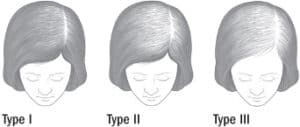The main type of hair loss in women is the same as in men. It's called Alopecia Androgenetica, or hair loss in women (or men). In men, hair loss usually begins above the forehead and the receding hairline eventually forms a characteristic “M” shape. Hair on the top of the head also thins, often leading to baldness. In women, Androgenetic Alopecia begins with gradual thinning at the parting line, followed by increasing diffuse hair loss radiating from the top of the head. A woman's hairline rarely disappears and women rarely go bald.
Want to know more about thinning hair in women? Click here!
There are many possible causes of hair loss in women, including medical conditions, medications, and physical or emotional stress. If you notice unusual hair loss of any kind, it is important to consult your doctor or a dermatologist to determine the cause and appropriate treatment. You can also ask your doctor for a referral to a therapist or support group to address emotional problems. Hair loss in women can be frustrating, but in recent years there has been an increase in resources to address the problem.

Image From Harvard Health
Almost every woman eventually develops some degree of hair loss. It can start any time after the onset of puberty, but women usually first notice it around menopause, when hair loss usually increases. The risk increases with age and is higher for women with a history of hair loss on both sides of the family.
As the name suggests, Androgenetic Alopecia involves the action of hormones called androgens, which are essential for normal sexual development and have other important functions in both sexes, including sex drive and regulation of hair growth. The condition can be inherited and involves several genes. It can also be the result of an underlying endocrine disorder, such as androgen overproduction or an androgen-secreting tumor on the ovary, pituitary gland, or adrenal gland. In both cases, Alopecia is likely related to increased androgenic activity. But unlike Androgenetic Alopecia in men, the precise role of androgens in women is more difficult to determine. If an androgen-secreting tumor is likely to be involved, it is important to measure androgen levels in women with marked hair loss.
In both sexes, hair loss due to Androgenetic Alopecia occurs due to a genetically determined shortening of anagen, the growth phase of a hair, and a prolongation of the time between the shedding of a hair and the beginning of a new anagen phase. (See “Life Cycle of a Hair.”) This means that it takes longer for hair to start growing again after being shed during the normal growth cycle. The hair follicle itself also changes, shrinking and producing a shorter, thinner hair shaft – a process called 'follicular miniaturization'. As a result, thicker, pigmented, longer-lived “terminal” hairs are replaced by shorter, thinner, non-pigmented hairs called “vellus”.

Image From Harvard Health
Each hair develops from a follicle – a narrow pocket in the skin – and goes through three growth phases. anagen (A), the active growth phase, lasts two to seven years. Catagen (B), the transition phase, lasts about two weeks. During this phase, the hair shaft moves up to the skin's surface and the dermal papilla (the structure that nourishes cells that give rise to hair) begins to separate from the follicle. The telogen (C), the resting phase, lasts about three months and culminates in the shedding of the hair shaft.
A doctor diagnoses hair loss in women by taking a medical history and examining the scalp. She or he will observe the pattern of hair loss, check for signs of inflammation or infection, and may order blood tests to investigate other possible causes of hair loss, including hyperthyroidism, hypothyroidism, and iron deficiency. Unless there are signs of excessive androgenic activity (such as menstrual irregularities, acne and unwanted hair growth), a hormonal evaluation is usually not necessary.
Hair Loss Treatment For Women
Medications are the most common treatment for hair loss in women. They include the following:
Minoxidil (Rogaine, generic versions)
This drug was initially introduced as a treatment for high blood pressure, but people who used it noticed that they were growing hair in places where they had lost it. Research studies confirmed that minoxidil applied directly to the scalp could stimulate hair growth. As a result of the studies, the FDA originally approved over-the-counter 2% minoxidil to treat hair loss in women. Since then, a 5% solution has also been available when a stronger solution is needed for a woman's hair loss.
Minoxidil is clearly not a miracle cure. While it can cause new growth of fine hair in some – not all – women, it cannot restore the full density of the lost hair. It is also not a quick fix for hair loss in women. You will not see results until you use the drug for at least two months. The effect often peaks around four months, but it can last longer, so plan for a trial period of six to twelve months. If minoxidil works for you, keep taking it to maintain those results. If you stop, you will lose hair again.
How to use minoxidil: make sure your hair and scalp are dry. Use the dropper or spray pump that comes with the over-the-counter solution and apply it twice daily to any area where your hair is thinning. Gently massage it into the scalp with your fingers so that it can reach the hair follicles. Then air dry your hair, wash your hands thoroughly and wash off any solution that has dripped onto your forehead or face. Then do not shampoo for at least four hours.
Some women find that the minoxidil solution leaves a deposit that dries and irritates their scalp. This irritation, called contact dermatitis, is likely not caused by the minoxidil itself, but rather by the alcohol included to aid drying.
Side effects and concerns: Minoxidil is safe, but it can have unpleasant side effects even apart from alcohol-related skin irritation. Sometimes the new hair differs in color and texture from the surrounding hair. Another risk is hypertrichosis – excessive hair growth in the wrong places, such as the cheeks or forehead. (This problem is more likely with the stronger 5% solution.)
Because the patent on Rogaine (the brand name version of minoxidil) has expired, there are many generic products available. They all contain the same amount of minoxidil, but some contain additional ingredients, such as herbal extracts, that can cause allergic reactions.
Anti-androgens
Androgens include testosterone and other “male” hormones, which can accelerate hair loss in women. Some women who do not respond to minoxidil may benefit from the addition of the antiandrogen drug spironolactone (Aldactone) for the treatment of androgenic alopecia. This is especially true for women with polycystic ovary syndrome (PCOS) because they tend to make excess androgens. Doctors commonly prescribe spironolactone along with an oral contraceptive for women of childbearing age. (A woman taking any of these drugs should not become pregnant because they can cause genital abnormalities in a male fetus.) Possible side effects include weight gain, loss of libido, depression, and fatigue.
Iron supplements
Iron deficiency can be a cause of hair loss in some women. Your doctor may test your blood iron levels, especially if you are vegetarian, have a history of anemia, or have heavy menstrual bleeding. If you are iron deficient, you should take a supplement and it can stop your hair loss. However, if your iron levels are normal, taking extra iron will only cause side effects, such as stomach upset and constipation.
Hair transplant
Hair transplantation is a procedure used in the United States since 1950 to treat Androgenetic Alopecia, involves removing a strip of scalp from the back of the head and using it to fill a bald spot. Today, 90% of hair transplant surgeons use a technique called follicular unit transplantation, which was introduced in the mid-XNUMXs.
During a FUE Treatment, we remove each graft from your scalp separately, without making a large incision as was previously done. Each graft is planted in a crevice in the scalp created by inserting a blade or needle into the area of missing hair. Hair grows naturally this way, in small clusters of one to four follicles called follicular units. As a result, the graft looks better than the larger “plugs” associated with hair transplants of yesteryear.



